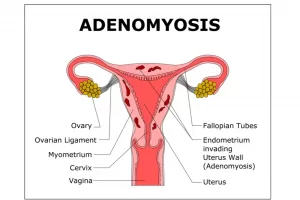Medically Reviewed by Dr Davinder Nagah
Last updated on 11.06.2024
What is Adenomyosis?
Adenomyosis is when the type of tissue that normally lines the uterus (endometrial tissue) also grows in the muscle layer of the uterus, where it continues to thicken, break down and bleed during each menstrual cycle.
How common is Adenomyosis?
Adenomyosis is thought to affect 20-35% of women, though it’s hard to be certain, as some women don’t have symptoms and Adenomyosis doesn’t always show up clearly on scans.
What are the symptoms of Adenomyosis?
Many women who have Adenomyosis do not get any symptoms. However, some women may experience symptoms which can have an impact on their normal daily activities and quality of life. These include:
- Heavy periods
- Long periods
- Painful periods
- Chronic pelvic pain or tenderness in the uterus
- Pain or pressure during sex (dyspareunia)
- If the uterus has enlarged due to Adenomyosis, there may be a sense of pressure in the pelvis
- Heavy periods can lead to low iron or anaemia, which may lead to fatigue, light-headedness and other symptoms
What causes Adenomyosis?
It is not known what causes Adenomyosis. It is most often diagnosed in a women aged between 30 and 50 (though it may have started at a younger age). As it needs oestrogen to grow, it goes away after menopause when the body’s oestrogen levels naturally fall. It is more common in women who have previously given birth or have had surgery on their uterus, such as a caesarean section. It also appears to be more common in women who got their first period at a younger age or who have a short menstrual cycle (less then 24 days).
There have been various theories put forward to explain why Adenomyosis develops in the first place:
- Invasive tissue growth- i.e. the cells that line the uterus (endometrial cells), invade the deeper muscle wall of the uterus. It is thought that surgical incisions to the uterus (for example, during a caesarean section) might trigger this.
- Inflammation of the lining of the uterus following childbirth may allow endometrial cells to invade the deeper muscle layer of the uterus
- It is possible that some endometrial cells might enter the muscle layer of the uterus in a developing female foetus, leading to Adenomyosis later in her life
- Another theory suggests that stem cells (from a woman’s own bone marrow) could invade the muscle layer and lead to Adenomyosis.
It is not certain which (if any) of these theories is correct.
How is Adenomyosis diagnosed?
A doctor may suspect Adenomyosis based on symptoms, or because the uterus feels bulky during a physical examination. It may also be picked up on an ultrasound scan. An MRI scan may also be helpful, as it can provide higher resolution pictures of the uterus. Sometimes assessment by a gynaecologist may be necessary for further investigation and to confirm the diagnosis.
What is an Adenomyoma?
Sometimes Adenomyosis can occur in the form of a benign (non-cancerous) lump, in the muscle wall of the uterus.
Is Adenomyosis the same as Endometriosis?
Adenomyosis and Endometriosis are generally considered to be separate conditions, but some experts believe they may be related or are variations of the same condition. In Endometriosis, the type of tissue that lines the uterus (endometrial tissue) forms in other places, such as the outside of the uterus, bowel or bladder. In Adenomyosis, endometrial tissue grows inside the muscle layer of the uterus. Some experts suggest that these processes are related, and that Adenomyosis is basically Endometriosis in the uterine muscle. However, others believe they are separate issues. Women can have Adenomyosis and Endometriosis at the same time, and the symptoms for the two conditions can be similar.
Does Adenomyosis affect fertility?
It is not yet clear if Adenomyosis significantly affects fertility. Some studies suggest that Adenomyosis may interfere with the movement of the fertilised egg from the fallopian tube to the uterus. It is also thought Adenomyosis may affect implantation (how the fertilised egg attaches to the lining of the uterus). However, more research is needed in this area.
What is the treatment for Adenomyosis?
Treatment may not be necessary if there are no symptoms. And if a woman is close to menopause, it should naturally get better as oestrogen levels drop.
If periods are long, heavy and/or painful, treatment for Adenomyosis may be considered:
- Anti-inflammatories can be taken just before a menstrual period and for the first day or two. This may reduce pain and make the bleeding a little lighter.
- Hormonal medications such as the pill (combined oral contraceptive pill) may also reduce heavy bleeding.
- Long acting contraceptives containing progesterone, such as an intrauterine device, “the rod” or contraceptive implant, may eliminate periods and thus symptoms of Adenomyosis.
- In severe cases, or where other treatments are not working or are unsuitable, surgery to remove the uterus (hysterectomy) may be considered.
Does Adenomyosis get better by itself?
As Adenomyosis is driven by oestrogen, it goes away once menopause occurs. Prior to menopause, hysterectomy (a procedure to remove the uterus) is the only way to get rid of Adenomyosis. Obviously, in women who wish to have future pregnancies, symptoms of Adenomyosis may be managed with medication.
When should you see a doctor?
If you have symptoms such as heavy painful periods, abnormal bleeding, pelvic pain or discomfort during sex, you should speak to your GP or gynaecologist.
Further patient resources
Article Resources

Getting a Mental Health Care Plan in Australia: Your Guide
Getting a Mental Health Care Plan in Australia: Your Guide Mental health matters—and if you’re feeling overwhelmed, anxious, or down, a mental health care plan can help. But what is it, and how do [...]
UTI Symptoms and Treatment: What You Need to Know
UTI Symptoms and Treatment: What You Need to Know Urinary Tract Infections (UTIs) are common, uncomfortable, and often disruptive. But what exactly are the signs to watch for, and how can you get relief [...]
Free Mental Health Care Plan Online | Bulk-Billed by Qoctor
Free Mental Health Care Plan Online | Bulk-Billed by Qoctor Discover how to get a free, bulk-billed Mental Health Care Plan (MHCP) in Australia through Qoctor's telehealth service. Accessing [...]





